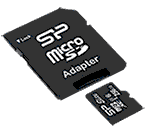For the everyday user, additional monolithic storage drives amounts to an aisle in their favorite electronic store. They stroll down the aisle, pick the drive that—according to the packaging—meets their needs, buy it, and simply plug and play. But if that aisle had a hood like a car, and you lifted it, you would see a complex world filled with unrivaled diversity. And that is what makes data recovery such a unique business.

The Diversity Of Electronic Storage.
Within the casing of some USB sticks, all MicroSD types, and some regular SD cards you can find surface mount (SMT) NAND wafers. Other flash storage drives can have NAND wafers that have legs on each side. These legs act as the connections to the circuit board (PCB). Lastly, some (when opened) have a solid circuit with no NAND chip (i.e. a monolithic or mono device). Each of these devices presents a unique challenge when data recovery is required. In fact, mono devices are some of the most complex storage types to recover files from.
NAND Wafers.
NAND flash memory chips are compact, fast, and cost-effective. They can handle large amounts of data. Memory chips withstand brutal upload, download and overwriting. These monolithic storage drives are tough.
What is a NAND flash wafer? If you’re thinking of a vanilla wafer, you’re in the wrong mindset! But you know how thin and delicate the layers of a vanilla wafer are. NAND wafers, although not eatable, are also thin and delicate. These pieces of high-tech equipment are why NAND memory is so compact and fast. NAND storage also makes for a data recovery challenge.
Only a few companies around the world have developed safe and effective NAND data recovery technology for accessing and reconstructing data dumps from corrupt or damaged NAND memory devices. eProvided, one of the few dealing directly with NAND data recovery.
The More Complex Monolithic Storage.
Monolithic storage memory is even more intricate than NAND. Monolithic flash memory’s composed of electronic components and their connections. Consequently, they are all built into a single layer’s semiconductor wafer. This wafer’s then diced into 3D integrated circuits (ICs).
Mono memory has become increasingly popular among storage drive manufacturers. Monoliths are cheaper to produce versus traditional controller and NAND devices. Mono memory is the next big breakthrough in USB, SD card and microSD memory device technology. In the meantime, it poses a challenge in the event of device damage or corruption.
Recovering data from monolithic storage is far more complex versus NAND. There is no room for error. In fact, most recovery companies won’t even attempt it. Some feel the complexity and time involved outweigh arriving at a fair price for the customer.
Access Raw Files inside Monolith Storage Based Drives
 eProvided is one of the few and leading data recovery experts capable of tackling monolithic memory recovery. NAND data recovery is the key to this success. Many of the leading file recovery companies (eProvided partners) send all their cases to the eProvided labs in Las Vegas, Nevada. Their cutting edge technology allows them to delve into complex memory devices. They carefully remove lost or damaged data for all customers. eProvided has the ability to access the RAW data from within the actual memory chips themselves. Their experienced hands are at your disposal for NAND flash and monolithic data recovery.
eProvided is one of the few and leading data recovery experts capable of tackling monolithic memory recovery. NAND data recovery is the key to this success. Many of the leading file recovery companies (eProvided partners) send all their cases to the eProvided labs in Las Vegas, Nevada. Their cutting edge technology allows them to delve into complex memory devices. They carefully remove lost or damaged data for all customers. eProvided has the ability to access the RAW data from within the actual memory chips themselves. Their experienced hands are at your disposal for NAND flash and monolithic data recovery.
Adjusting To Ever Changing Memory Technology.
Technology constantly improves. As the information technology industry improves, flash memory performance will improve. New devices that are more compact should be expected. It is imperative that data recovery specialists keep up. The creation of NAND flash and monolithic storage memory storage drives present document recovery experts with a challenge. Some companies have chosen to ignore the challenge, a few eProvided included decided to tackle it head on. As a result, you can rest assured that every effort will be spent to recovery your data. Accordingly, in the event of any damage or corruption on any storage device.
As the technology matures, you can to, regardless of what memory types you purchase in your computer store. Always remember to have a back-up plan. Back your data up regularly to a secure location. You never know when your memory device will fall victim to unforeseen accidents. Water damage, breaks, or bends happen at random.

